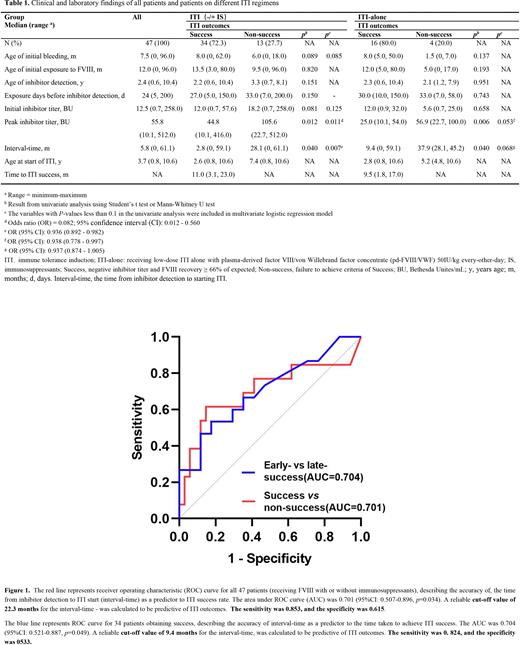Abstract
Background Shorter time from inhibitor detection to immune tolerance induction (ITI) start (interval-time) might play a critical role in ITI outcomes for severe Hemophilia A (SHA) children with high-titer inhibitors. However, the acceptable interval-time hasn't well been confirmed yet, especially for treatment-delay patients undergoing low-dose ITI therapy in China.
Aim To explore the interval-time in Chinese SHA children with high-titer inhibitors, undergoing low-dose ITI strategy with outcomes.
Methods A retrospective study in single center, 47 Chinese SHA children with high-titer inhibitors [> 10 Bethesda Unite (BU)/ml] undergoing low-dose ITI strategy with more than 24 months follow-up period. ITI outcomes were evaluated at the 24th month of treatment. The association between interval-time and outcomes was analyzed. Success was defined as negative inhibitor titer and FVIII recovery ≥ 66% of expected. The predictive ability of interval-time to identify ITI success was determined using receiver operating characteristic (ROC) curve.
Results Forty-seven cases enrolled in this study, the median age of inhibitor detection was 2.4 (range, 0.6, 10.4) years and the interval-time was 5.8 (0, 61.1) months with the peak inhibitor titer of 55.8 (10.1, 512.0) BU/ml, 42.6% (20/47) using ITI-alone and 57.4% using ITI combined with Rituximab based immunosuppression (IS). Over a follow-up time of 31.3 (24.0, 69.5) months, 34 patients (72.3%) achieved success with the time to success of 11.0 (3.1, 23.0) months. (Table 1)
The interval-time in ITI success group was shorter than in non-success group significantly [2.8 (0. 59.1) vs 28.1 (0, 61.1) months, p = 0.04]. Multivariate logistic regression model demonstrated the peak inhibitor titer and the interval-time were two independent predictors of ITI success (P < 0.05). The area under ROC curve (AUC) was 0.701 (95%CI: 0.507 - 0.896, p = 0.034) and reliable cut-off value of 22.3 months could be calculated in the prediction of ITI outcomes with the sensitivity of 0.853 and the specificity of 0.615. (Figure 1)
Univariable linear regression demonstrated the relationship between the time to success and the interval-time, the equation y=0.1552*x+9.285 (R2 = 0.2252, p = 0.005). ROC curve describing the accuracy of the predictor of early-success (ITI time < 12 months); the AUC was 0.704 (95%CI: 0.521 - 0.887, p = 0.049); the cut-off value was 9.4 months with the sensitivity of 0.824 and the specificity of 0.533. (Figure 1)
Conclusions Our study shows that shorter interval-time was associated with better inhibitor eradication outcomes in terms of ITI success rate and time to success in our SHA children with high-titer inhibitors (> 10BU/ml) undergoing low-dose ITI strategy.
We showed that an interval-time of ≤ 22.3 months was associated with higher ITI success rate. And an interval-time of ≤ 9.4 months was related to shorter time to success.
Our study on low-dose ITI in a developing country setting support the findings using higher dose ITI in developed countries setting that ITI should be started as soon as possible after inhibitor development. However, stronger evidence is needed from further clinical studies with better study design.
Disclosures
Poon:Bayer, Bioverativ/Sanofi, CSL-Behring, KVR Pharmaceutical, Novo Nordisk, Pfizer, Roche, Sobi, Takeda: Honoraria; Bayer, CSL-Behring: Research Funding.
Author notes
Asterisk with author names denotes non-ASH members.


